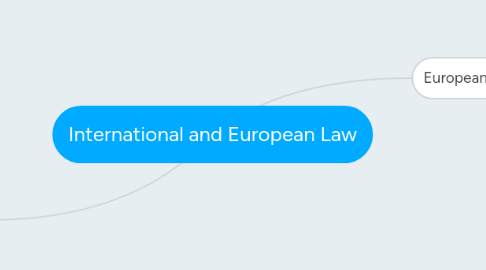
1. International Law
1.1. Subjects
1.1.1. States
1.1.1.1. What is a state
1.1.1.1.1. 1. defined territory
1.1.1.1.2. 2. permanent population
1.1.1.1.3. 3. effective control by government
1.1.1.1.4. (4. regonition by other states)
1.1.1.2. State sovereignty
1.1.1.2.1. states can regulate everything as they want to without interference from other sovereign states
1.1.2. Others
1.1.2.1. International Organizations
1.1.2.2. Individuals
1.1.2.3. Liberation movements
1.1.2.4. Transnational companies
1.2. What
1.2.1. art. 38 ICJ Statute
1.2.1.1. treaties
1.2.1.1.1. "contract" between states
1.2.1.1.2. when ratified, states can´t act contrary
1.2.1.2. customary law
1.2.1.2.1. opiono iuris
1.2.1.2.2. usus
1.2.1.3. general principles of law
1.2.1.4. judicial decisions
1.2.1.5. teaching
1.3. implementation
1.3.1. incoporation
1.3.1.1. individuals can directly rely on international law, because international law has direct force in nat. law
1.3.1.2. NL
1.3.2. transformation
1.3.2.1. int. law needs to be made into nat. law
1.3.2.2. GER
1.4. United Nations
1.4.1. aims and principles art. 1 and 2 UN Charter
1.4.2. General assembly art. 9 f UN Charter
1.4.3. Security Council art. 23 f. UN Charter
1.4.3.1. 5 permanent Members
1.4.3.2. can make binding decisions art. 25 jo. 39 UN Charter
1.4.4. ICJ art. 92 f. UN Charter
1.4.4.1. art. 36 ICJ Statute ICJ has jurisdiction over interpretation and validity
1.4.4.1.1. if parties refer case to ICJ
1.4.4.1.2. if matter should be decided by ICJ acc. to UN Charter
1.4.4.1.3. declaration of states to accept jurisdiction
1.4.4.2. art. 65 ICJ Statute advisory opinions
1.4.4.3. art. 94 UN Charter decisions binding
2. European Law
2.1. Development
2.1.1. European Coal and Steel Community
2.1.1.1. European Economic Community
2.1.1.1.1. Common Internal market
2.2. Sources
2.2.1. TEU and TFEU ->primary sources
2.2.2. Regulations, Directives and Decisions -> art. 228 TFEU secondary legislation
2.2.2.1. Regulations
2.2.2.1.1. binding in its entirety
2.2.2.1.2. general application
2.2.2.1.3. directly applicable
2.2.2.1.4. individuals can rely on them in nat. court
2.2.2.2. Directives
2.2.2.2.1. MS can decide how to implement
2.2.2.2.2. binding in result to be achieved
2.2.2.2.3. not directly applicable
2.2.2.2.4. individuals can rely on them in nat. courts, only if not implemented in time
2.2.2.3. decisions
2.2.2.3.1. binding in their entirity
2.2.2.3.2. only to whom adressed
2.2.2.4. Recommendations and opinions
2.2.2.4.1. not binding
2.2.3. General Principles of European Law
2.2.3.1. case law basics
2.2.3.1.1. Van Gend en Loos
2.2.3.1.2. Costa v ENEL
2.2.3.2. principles from art. 4(4) TEU and 5 TEU
2.2.3.2.1. principle of sincere cooperation
2.2.3.2.2. principle of conferral
2.2.3.2.3. principle of subsidiarity
2.2.4. Decisions by ECJ
2.3. institutions
2.3.1. European Council art. 15 TEU
2.3.2. Council of Ministers art. 16 TEU
2.3.3. European Commission art. 17 TEU
2.3.4. European Parliament art. 14 TEU
2.3.5. European Court of Justice art. 19 TEU and 258-268 TFEU
2.4. content/ substantive
2.4.1. citizenship art. 20 TFEU
2.4.2. internal market art. 26 (2) TFEU
2.4.2.1. free movement of goods art. 28 TFEU
2.4.2.2. free movement of workers art. 45 TFEU
2.4.2.3. free movement of services art. 56 TFEU
2.4.2.4. free movement of capital art. 63 TFEU
2.4.2.5. rules on competition art. 101 TFEU
